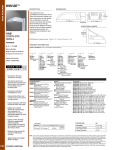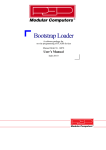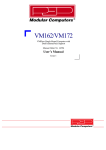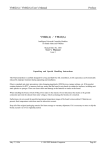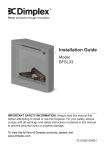Download VMXX2 documentation
Transcript
BSP Package 2.0.2. XTOOLS CENTER Tornado 1.0.x BSP Name :VMx42/x62 BSP Release:2.0.3 Issue 1.50 VM42/VM62/VM42LC/VM642/VM662 Board Support Package VM42/VM62/VM42LC/VM642/VM662 Board Support Package User’s Manual Issue : 1.50 1/25 REVISION HISTORY Tornado BSP Package 2.0.2. Brief Description of Changes BSP Release Issue 1.00 1.10 1.20 Creation (Update from VxWorks 5.2) Add SCC driver and ER96001 WindView Support and Ehernet Driver update (ER96003) Update BSP for supporting VM42 LC Update for BSP Package 2.0.2. Update BSP Package 2.0.2. / BSP Version 2.0.3 1.3 1.4 1.5 2.0.0 2.0.1 2.0.2 2.0.2 2.0.2 2.0.3 Date of Issue Author 13 May, 1996 8 July, 1996 9 December, 1996 16 April, 1997 30 May, 1997 July 22, 1997 BO BO BO BO BO BO This new version (2.0.3) of software supports : • BSP upgrade to version 2.0.3 Next are the known problems and solutions included in this BSP release : • The Ethernet driver of the VM42 / VM62 is delayed and this when the network traffic is very high and the VM42 / VM62 is constantly using the Ethernet driver. • The Eeprom on the VM42 / VM62 is used to store data regarding the board, like the ethernet address and the bootline. It happened that not all the characters stored in the bootline where correctly read, although they seemed to be correctly stored in the Eeprom. • When you want to reset a VM42 / VM62 with the reboot command on the target shell, while an application communicates with an other board and the BNC Ethernet connector is removed, the reboot command is not executed. vmxx2.doc 2/25 When you reconnect the BNC Ethernet connector, the communication between the VM42 / VM62 and the other CPU board continues executing. But the reboot command is never executed. When a VM42 / VM62 without BNC Ethernet connector is used, the board reboots correctly as wanted. • In the standard BSP delivery, the BSP was configured to boot in the VxWorks 5.2 configuration; this means with the shell onboard. The BSP was also configured to include a Wind View header file, even if Wind View was not installed (timestampDev.h). vmxx2.doc 3/25 Table of contents. 1. INTRODUCTION ____________________________________________________6 2. MAIN FEATURES ___________________________________________________6 3. BSP INSTALLATION_________________________________________________7 3.1 File Structure_____________________________________________________________ 8 3.1.1 Delivered files________________________________________________________________ 8 3.2 Program your bootrom in the VM42 FLASHES ________________________________ 9 3.2.1 Build your bootprom image._____________________________________________________ 9 3.2.2 Program the bootprom image into flashes. _________________________________________ 9 3.3 Configure your Boot Shell parameters _______________________________________ 10 3.4 Bootline in flash eprom ____________________________________________________ 11 3.5 VM42 LC _______________________________________________________________ 12 4. DEVICES__________________________________________________________13 4.1 Memory map ____________________________________________________________ 13 4.1.1 Flash eproms________________________________________________________________ 13 4.1.2 DRAM ____________________________________________________________________ 13 4.1.3 Addresses __________________________________________________________________ 13 4.2 SMC Serial Port _________________________________________________________ 14 4.2.1 Port definition_______________________________________________________________ 14 4.2.2 Number of available ports _____________________________________________________ 14 4.2.3 Console definition ___________________________________________________________ 14 4.3 SCC Serial Ports _________________________________________________________ 15 4.3.1 Port definition_______________________________________________________________ 15 4.3.2 Number of available ports _____________________________________________________ 16 4.4 TIMERS _______________________________________________________________ 17 4.4.1 System Clock _______________________________________________________________ 17 4.4.2 Auxiliary Timer _____________________________________________________________ 17 4.4.3 Timestamp Timer ____________________________________________________________ 17 4.5 Shared memory and Backplane driver _______________________________________ 18 4.5.1 Processor number ____________________________________________________________ 4.5.2 DUAL RAM size ____________________________________________________________ 4.5.3 DUAL RAM On board access __________________________________________________ 4.5.4 DUAL RAM VME Access _____________________________________________________ 4.5.5 Mailboxes __________________________________________________________________ 18 18 18 19 19 4.6 WindView ______________________________________________________________ 20 5. THE LIBMC680X0GNUVM4262.A LIBRARY____________________________21 5.1 E2PROM _______________________________________________________________ 21 5.2 Real Time Clock _________________________________________________________ 22 5.3 Ethernet Driver __________________________________________________________ 22 5.4 CPU Speed detection______________________________________________________ 22 vmxx2.doc 4/25 6. BOOT FROM THE VME BUS_________________________________________23 6.1 Build the needed bootrom image ____________________________________________ 23 6.2 Build the needed OS ______________________________________________________ 23 6.3 Configure your VMEM-S2_________________________________________________ 24 6.4 Configure the VM42/VM62 ________________________________________________ 24 6.5 Configure your VME BUS _________________________________________________ 25 6.6 Configure your boot parameters and boot ____________________________________ 25 vmxx2.doc 5/25 1. INTRODUCTION The purpose of this document is to describe the specificity of the PEP VM42 / VM62 Board Support Package for Tornado 1.0 (VxWorks 5.3). 2. MAIN FEATURES The VM42/VM62 BSP supports: • all CPU clock frequency.(25,33 Mhz) • the system Clock using the Periodic Interrupt Timer (PIT) of the MC68360 • the 2 SMC serial ports (RS-232) of the MC68360 • the 4 SCC serial ports (RS-232) of the MC68360 • the Ethernet controller using SCC1 of the MC68360 • the MMU and Cache of the MC68040 • the 2Kbits (256 bytes) E2PROM • the RTC chip • the shared memory driver using the onboard dual ported SRAM • the VME interface and interrupt controller • the auxiliary timer • the timestamp driver (for Windview) • the bootline can be stored in eprom, e2prom or at fixed place in flash eprom vmxx2.doc 6/25 3. BSP INSTALLATION Warning The Pep delivery of the BSP contains a standard Wind River header file. In this release Pep Modular Computers had to modify this standard header file : m68360.h. When the BSP is installed check if the Pep delivery has updated this m68360.h header file. The modification history of this m68360.h file should show “add Pep Specific structures and defines” Please refer to the Installation Note for the installation of this BSP. vmxx2.doc 7/25 3.1 File Structure 3.1.1 Delivered files config / pvm42* WIND_BASE target tyCoDrv.c bootrom.hex symTbl.c pkLib.c romInit.s sysLib.c sysALib.s config.h Makefile pvm42.h sim60.h libMC68040gnuvm4262.lib / src / drv / h / drv / mem / e2VM42.c timer / m68360Timer.c serial / m360SMCPep.c serial / m360SCCPep.c timer / timerDev.h timer / m360Timers.h serial / tyIoctlPep.h serial / m360SMCPep.h serial / m360SCCPep.h multi / m68360.h multi / m68360Pep.h multi/quicc.h multi/pram.h multi/registers.h Modified Wind River File * for the VM42 LC, the directory pvm42LC is created vmxx2.doc 8/25 3.2 Program your bootrom in the VM42 FLASHES 3.2.1 Build your bootprom image. A standard bootrom.hex file can be found in the delivery in the directory config/pvm42. If a new boot image file needs to be generated, run the makefile with the 'bootrom.hex' entry, so that the bootrom image for the flash eproms is generated. make bootrom.hex 3.2.2 Program the bootprom image into flashes. The bootrom.hex file needs to be programmed in flash eprom. Use the Boot Strap Loader of the VM42/VM42LC/VM62 to do so. (Refer to the appendix of the Boot Strap Loader of the VM42/VM62 hardware manual for more information regarding this issue). vmxx2.doc 9/25 3.3 Configure your Boot Shell parameters Check the Entering Boot Parameters chapter of the Tornado User’s Guide for a complete description of all the needed boot parameters. Next you will find an example of such boot parameters. [VxWorks Boot]: c boot device: processor number: host name: file name: inet on Ethernet: host inet: user name: pep 0 mysun /usr/tornado/target/config/pvm42/vxWorks 128.0.0.128 128.0.0.1 vw [VxWorks Boot]: @ And your system should boot vmxx2.doc 10/25 3.4 Bootline in flash eprom The bootline can be stored in : Ü e2prom : standard configuration Ü at a fixed place in the flash eprom (always at the end of the first bank) The first time the board boots there is not yet a bootline in the e2prom. At that point the BSP takes the standard bootline, defined in the config.h file and stores it in the e2prom. From then the BSP takes the content of the e2prom as bootline. For saving the bootline in the flash eprom add the define FLASH_BOOTLINE in the config.h file and the bootline will be saved in the flash eprom. In the config.h file remove the /* and */ : /* Bootline in flash eprom /* The bootline can be put at a fixed address /* in the flash eproms /* #define FLASH_BOOTLINE */ */ */ */ The address where the bootline is stored depends on the flash eproms used. The supported (tested) flash eproms are the 29F010 and 29F040. Since this address depends on this type of flash eproms, the BSP displays the address before retrieving and writing the bootline. vmxx2.doc 11/25 3.5 VM42 LC The difference between a VM42 and a VM42 LC board is that the VM42 LC has no floating point hardware registers nor instructions to handle them and so all this has to be done by software . For generation of the VM42 LC BSP boot eproms and image file, the next definitions are changed in the Makefile file, compared to a normal VM42 BSP : • CPU = MC68040 into CPU = MC68LC040 ‚ TARGET_DIR = pvm42 into TARGET_DIR = pvm42lc where pvm42lc is the directory where the BSP is installed in. (/usr/vw/config/pvm42lc) From this moment on your make command will compile for a MC68LC040 CPU. vmxx2.doc 12/25 4. DEVICES 4.1 Memory map 4.1.1 Flash eproms The 32bits wide Flash eprom is available in 2 different sizes: 1 MB: 4 MB: divided in 2 banks of 512 divided in 2 banks of 2 MB Each bank can be separately protected (see Jumper B1 of the DM600 configuration in the VM42/VM62 User's Manual) The BSP configures that area from 0x4000000 to 0x4400000. The default configuration of the BSP is for 1 MB flash eproms. This should be changed in the MakeSkel and config.h ROMSIZE = 0x400000 4.1.2 DRAM The 32bits wide DRAM is available in 2 differenet sizes: 4 or 16 MB. The default configuration of the BSP is for 4 MB DRAM. The size of this memory can be easily changed to 16MB in config.h LOCAL_MEM_SIZE = 0x1000000 4.1.3 Addresses See VM42/VM62 User’s Manual for memory mapping. vmxx2.doc 13/25 4.2 SMC Serial Port 4.2.1 Port definition The two SMC serial ports are available on the front panel. The SMC1 serial port is the upper port (port0: /tyCo/0). The SMC2 serial port is the lower port. (port1: /tyCo/1). 4.2.2 Number of available ports The number of available port can be changed in config.h (default is 2). It can be reduced to 1 by: #undef NUM_TTY #define NUM_TTY 1 4.2.3 Console definition The console is defined by default on the lower port (1) This can be changed to the upper port in config.h: #undef CONSOLE_TTY #define CONSOLE_TTY 0 Only the SMC Serial ports can be used as Console and not the SCC Serial ports. vmxx2.doc 14/25 4.3 SCC Serial Ports refer to “SCC 68360 Driver Specification Version 1.0” 4.3.1 Port definition On a standard VM42 / VM62 there is only one SCC port available, this is the SCC1 port that is used for an ethernet connection with the host. Here it is not a serial port any more. When there is no ethernet connection on the VM42 / VM62 this SCC1 port can be used as a serial channel. SSC1 S C C 1 SCC1 Ethernet SMC1 Ethernet Piggy Back SCC1 SCC4 Serial Piggy Back SMC2 SSC4 SMC1 SMC2 There are totally 4 SCC serial ports available : SCC1 to SCC4. The SCC1 serial port 1 : /tyScc360/1 The SCC2 serial port 2 : /tyScc360/2 The SCC3 serial port 3 : /tyScc360/3 The SCC4 serial port 4 : /tyScc360/4 vmxx2.doc On front panel Redirected to CXC connector Redirected to CXC connector On front panel and redirected on CXC connector 15/25 4.3.2 Number of available ports The number of available port can be changed in config.h (default is 0). It can be changed by: #define NUM_SCC 1 #define NUM_SCC 2 #define NUM_SCC 3 #define NUM_SCC 4 for only use SCC 1 (when not used as ethernet) for use of SCC1 and SCC2 for use of SCC1, SCC2 and SCC3 for use of SCC1, SCC2, SCC3 and SCC4 Remark : When the SCC1 is used as ethernet device and the user wants to instal a serial device on SCC1, the driver will return without changing the ethernet device on SCC1. This SCC Serial driver can not be used as a bridge, a console or as a debugging help by/for the BSP. It can only be used in an application written by the user. Standard the SCC Serial driver is not initialised at boot (refer to Number of available ports to configure the use of the SCC Serial channels). vmxx2.doc 16/25 4.4 TIMERS 4.4.1 System Clock The timer used for the system clock is the PIT Timer of the MC68360. The default value is 60Hz. (60 ticks per second). The clock frequency can be ranged from 10 to 1000 Hz. This timer is configured to give a 0 shift to any tick rate. Use the sysClkRateSet and sysClkRateGet function to modify or read the system clock speed. Use sysClkEnable and sysClkDisable to enable or disable the timer interrupts. 4.4.2 Auxiliary Timer The auxiliary timer uses the TIMERS1 and 2 of the MC68360. Its period is 320 ns (F=3,125 Mhz). Use the sysAuxClkRateSet and sysAuxClkRateGet function to modify or read the system clock speed. Use sysAuxClkEnable and sysAuxClkDisable to enable or disable the timer interrupts. Use sysAuxClkConnect to add a callout function (with parameter) to the auxiliary timer interrupts. 4.4.3 Timestamp Timer The timestamp driver uses TIMERS3 and 4 of the MC68360. Its period is 320 ns (F=3.125 Mhz). Its rollover period is 1 second. The timestamp driver is only included when INCLUDE_TIMESTAMP is defined in config.h This timer is used for Windview. Use sysTimestampEnable and sysTimestampDisable to enable and disable the timestamp timer. Use sysTimestamp to read the timer value. Use sysTimestampConnect to add a callout function (with parameter) the the timer interrupts. vmxx2.doc 17/25 4.5 Shared memory and Backplane driver 4.5.1 Processor number Each board in the VME system has a processor number. This processor number is defined in the VxWorks boot parameters (stored in E2PROM). It can be changed from the boot shell. Main CPU board has processor number 0. Other CPU boards (booting from the VME bus shared memory driver) should have processor number 1,2,3... 4.5.2 DUAL RAM size The dual ported RAM size can be either 256KB or 1MB. This is changed in config.h #define SRAM_MEM_SIZE 0x40000 #define SRAM_MEM_SIZE 0x100000 /* for 256 KByte SRAM */ /* for 1 MByte SRAM */ 0xCA03FFFF or 0xCAFFFFFF 0x87?3FFFF or 0x87?FFFFF SHARED MEMORY 0xCA001FFF 0x87?01FFF MAILBOX INT SRAM 0xCA000000 0x87?00000 4.5.3 DUAL RAM On board access The onboard access can be done from 0xCA000000. The real dual ported address range is: from 0xCA002000 to 0xCA040000 for the 256KB version and from 0xCA002000 to 0xCA0FFFFF for the 1MB version. vmxx2.doc 18/25 4.5.4 DUAL RAM VME Access Another boards can only access the dual port memory aboce 0x87?02000. The first 8KB are reserved for the Mailbox Interrupts. The VME base address depends on the CPU board cpu number. CPU 0 starts at VME address 0x87100000. CPU 1 starts at VME address 0x87200000. ... The address range is then: from 0x87?02000 to 0x87?3FFFF for the 256KB version from 0x87?02000 to 0x87?FFFFF for the 1MB version 4.5.5 Mailboxes Mailboxes are used for the communication between VM42/VM62 cpu boards. Access to the Local Mailbox is done through the bit7 of the board control register (0xCD000005). Access to the VME Mailbox is done at the board base adress: 0x87?00000. vmxx2.doc 19/25 4.6 WindView The use of WindView 1.0.1. is tested with Tornado 1.0 running under Unix. (Solaris 2.5) To include the time stamp driver and the needed initialisation for WindView, just include the next defines in your config.h file. /* Windview and TIMESTAMP driver */ #if TRUE #define INCLUDE_INSTRUMENTATION #define INCLUDE_WINDVIEW #define INCLUDE_TIMESTAMP #endif vmxx2.doc 20/25 5. THE LIBMC680X0GNUVM4262.A LIBRARY 5.1 E2PROM This library supports the VM42/VM62 onboard E2PROM. The first 1kbit is reserved for PEP data. The second kbit can be used for example for the storage of the VxWorks boot parameters. The following structure is made for the PEP data part : part named dummy part named Profibus part named Ethernet part named Reserved part named Bootline with offset 0 and with offset 18 and with offset 20 and with offset 23 and with offset 64 and length 18 length 2 length 3 length 41 length 64 (36 bytes) (4 bytes) (6 bytes) (82 bytes) (128 bytes) The functions that are available in the normal BSP’s are : e2readEther e2readBootline e2readDummy e2readProfibus e2writeBootline e2writeProfibus reads the VM42/VM62 Ethernet Address reads the stored bootline reads the stored info in the dummy part reads the Profibus info from the e2prom writes the Bootline to the e2prom writes the Profibus to the e2prom inizSPI seReSPI Initialises the SPI Controller Internal function : Send/Receive Bytes over SPI select e2prom deselects e2prom reads e2prom location writes e2prom location selChip deSelChip rdE2 wrE2 The functions that only are available in PEP Internal BSP’s are : e2writeDummy e2writeEther dumpE2 vmxx2.doc writes the Dummy info to the e2prom writes the Ethernet address to the e2prom dumps the whole content of the e2prom 21/25 5.2 Real Time Clock The library supports the VM42/VM62 onboard real time clock (V3021). STATUS rtcInit() STATUS rtcSet ( struct tm *t) STATUS rtcGet ( struct tm *t) Initialize the RTC access Set Date and Time in UNIX like structure Get Date and Time in UNIX like structure 5.3 Ethernet Driver The VM42/VM62 supports the onboard Ethernet controller on SCC1. m360attach() attaches the VM42/VM62 Ethernet device. The Ethernet address is read from the VM42/VM62 serial E2PROM. Only one Ethernet device is supported. 5.4 CPU Speed detection A function is used to detect the MC68360 CPU clock speed. The use of this function might strongly disturb the auxiliary and timestamp timers. To avoid further call to that function, a global variable cpuClkSpeed is assigned with the calculated CPU speed. vmxx2.doc 22/25 6. BOOT FROM THE VME BUS In order to boot your VM42/62 board from the VME bus, you need to build a new VxWorks boot image and operating system. 6.1 Build the needed bootrom image Modify the default startup entry of the makefile for this purpose: # Values for VME boot ROM_TEXT_ADRS ROM_SIZE = 87000008 = 00100000 # ROM entry address after reset # number of bytes of ROM space and remake the needed bootrom.hex image file make bootrom.hex 6.2 Build the needed OS Modify the default startup entry of the config.h for this purpose: /* * Warning: The following definitions must be kept * synchronized with the * Values in MakeSkel * * To build bootprom or resident version starting at the VME * base address, define VME_BOOT. * You can know put this image in a memory board and * configure the memory * board to start at VME address 0. */ #define VME_BOOT #ifdef VME_BOOT /* VME Base address */ #define ROM_BASE_ADRS 0x87000000 #else /* base address of FLASH */ #define ROM_BASE_ADRS 0x04000000 #endif and run the make command again. make vmxx2.doc 23/25 6.3 Configure your VMEM-S2 O D D D E V E N 6.4 Configure the VM42/VM62 You need to set the jumper J8 in order to boot from the VME Bus. vmxx2.doc 24/25 6.5 Configure your VME BUS Remove BG3 and IACK jumper on the first slot (for old VME buses with backplane jumpers) Put the VM42/VM62 in the first slot. Put the VMEM-S2 in the second slot. Power up your system. After a while (about 10 seconds), you will get the VxWorks Boot countdown. Press any key to get the boot prompt. 6.6 Configure your boot parameters and boot Use the 'c' command to configure your boot parameters Use the '@' command to boot. vmxx2.doc 25/25


























